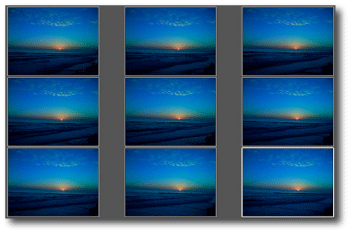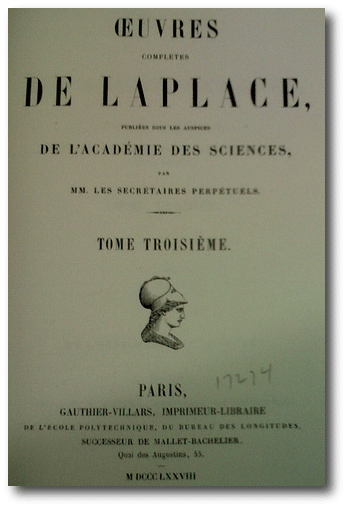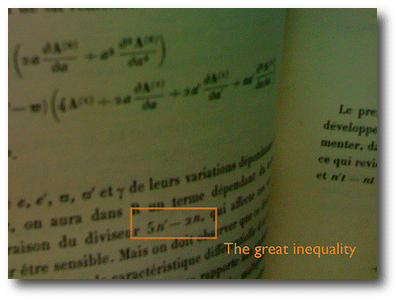
Image Source.
On the UCSC Science Library shelves, we have an 1828 edition of Pierre Simon de Laplace’s Oeuvres that includes the five-volume Mecanique Celeste. At moments like this, it’s great to have a camera on one’s cellphone:

Image Source.
Laplace’s identification of the 5:2 near-resonance between Jupiter and Saturn allowed him to augment the exisiting second-order Laplace-Lagrange secular analysis to produce a theory of planetary motion that was in extraordinary agreement with the observations of the late eighteenth century. His success in explaining the so-called Great Inequality was likely a contributing factor in the development the concept of Laplacian determinism, of a clockwork universe.

In 1802, during William Herschel’s visit to Paris, Herschel and Laplace had a meeting with Napoleon, who, like Thomas Jefferson, appears to have been not much taken with a system of the world created and dictated by natural law:
The first Consul then asked a few questions relating to Astronomy and the construction of the heavens to which I made such answers as seemed to give him great satisfaction. He also addressed himself to Mr. Laplace on the same subject, and held a considerable argument with him in which he differed from that eminent mathematician. The difference was occasioned by an exclamation of the first Consul, who asked in a tone of exclamation or admiration (when we were speaking of the extent of the sidereal heavens): “And who is the author of all this!” Monsieur De la Place wished to shew that a chain of natural causes would account for the construction and preservation of the wonderful system. This the first Consul rather opposed.
[Source: Herschel’s diary of his visit to Paris in 1802, as found in C. Lubbock’s _The Herschel Chronicle_, p. 310, see here for a nice background.]
I like the extrasolar planet game because it’s simultaneously up-to-the-minute and steeped in tradition. With systems like Gliese 876, we’re approaching roughly the same effective degree of refinement in our detection of planet-planet orbital perturbations that was possible in the late eighteenth century for Jupiter and Saturn. As a result, someone like Laplace, were he to materialize (see today’s NYT) in the Interdisciplinary Sciences Building here at UCSC, could roll up his french cuffs and immediately begin contributing publishable work. The same would certainly not be true if one of his equally luminous scientific contemporaries, say Antoine Lavoisier, were to suddenly walk in to a modern-day chemistry lab.
Will be making an effort to post more frequently. Thanks for your continued readership and participation as oklo.org heads into its third year.

Hi Greg,
talking about systems with known resonances, a team from the McDonald Observatory was going to present results of astrometric measurements made with Hubble of Upsilon Andromedae at the 211th AAS meeting. I was hoping for some news on this but I could not find it anywhere. Is there any knowledge of this in “the backstage” ?
Cheers,
Luis
(looking forward for the HD80606 and HAT-P-2b results :-))
Likewise looking forward to info about HD 80606 and HAT-P-2b.
I wonder how well-constrained the data about some of these systems is. After all, the inclinations of the outer two planets of PSR B1257+12 have been determined (including the mutual inclination) by detecting their perturbations on each other, but then pulsars give very good accuracy.
I wonder how well the 55 Cancri system can be constrained, particularly the inner planets: with around 20 years of data, and the near 3:1 resonance of short-period planets b and c, could mutual inclinations be determined?